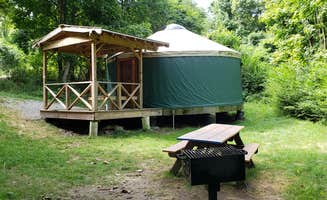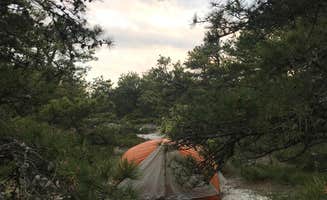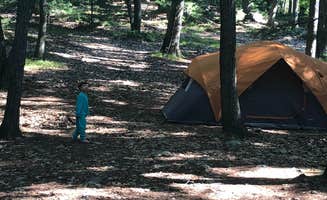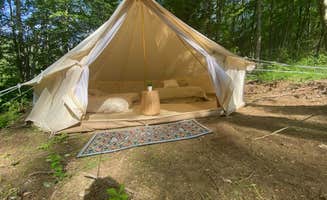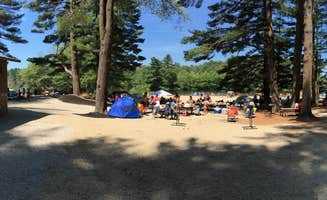Tent camping near Assonet, Massachusetts offers access to a mix of coastal and woodland environments within southeastern Massachusetts. The area sits at modest elevations near sea level with a humid continental climate featuring warm summers and moderately cold winters. Seasonal considerations significantly impact camping experiences, with summer temperatures typically ranging from 60-85°F while spring and fall camping requires preparation for overnight temperatures that can drop into the 40s.
What to do
Explore historic coastal forts: Boston Harbor Islands State Park Campground features abandoned military installations perfect for history enthusiasts. "We found all kinds of bunkers and a brick house. We ended up making a fire pit on the beach and a flat rock 'grill' to make our burgers," notes one camper about Lovells Island.
Wildlife observation opportunities: Morning birding yields diverse sightings during migration seasons. At Washburn Island Campsites, the isolated setting creates excellent wildlife viewing. "Small island with 10 camp sites all with views of the water very quiet at night," reports one visitor who stayed in May.
Evening beach activities: Nighttime beach exploration offers unique experiences. "Fires are permitted at the beach and I was lucky to witness a really beautiful beach sunset," explains a camper who hiked to the primitive sites at Sandy Neck Beach Park.
Seasonal berry picking: Mid-August visitors can forage for wild blackberries on certain islands. "In mid-August we collected handfuls of blackberries as we explored Peddocks," mentions a Boston Harbor Islands camper.
What campers like
Island isolation: The remote feeling despite proximity to urban areas draws many tent campers. "Camping at Boston Harbor Islands requires some planning, but you get the benefit of a remote island with minimal company," explains one visitor to Peddocks Island.
Secluded beaches: The reward for challenging hikes through sand includes private shorelines. "Overall, this is a 5 star primitive spot for me because it's secluded, requires a bit of leg work and has a great view," shares a visitor about Sandy Neck Beach Park Primitive Campsites.
Proximity to water: Nearly all tent sites in the region offer direct water access or views. "You need a boat or a ride out there, close to the main land so a canoe/kayak would work," notes a Washburn Island camper who appreciated the island's water accessibility.
Weather variability: Shoulder season camping (May, September, October) offers significantly lower crowds. "This campground is only open during the summer months," explains a Boston Harbor visitor, highlighting the importance of seasonal planning.
What you should know
Transportation logistics: Island camping requires planning boat transportation. "Getting to the island was a bit of a hassle. We live in Boston and took all of our gear on the T to the harbor by the aquarium," explains a Lovells Island camper who navigated multiple ferry connections.
Booking windows: Securing campsites requires advance planning. For Camp Nihan Education Center, availability depends on renovation schedules: "I can't wait til the current renovation is done so we can go there again soon," notes one visitor.
Equipment transportation: Pack efficiently when accessing island or remote sites. "If you have a folding wagon, you may appreciate having it to carry items on and off the ferry and to your site on the island," advises a Boston Harbor Islands camper.
Water requirements: Potable water access varies drastically between sites. "Make sure that you bring enough drinking water and that you are ok with using the composting bathroom or going in the woods," warns a Lovells Island visitor.
Tips for camping with families
Educational opportunities: Several campgrounds offer junior ranger programs and nature education. "Earn a Junior Ranger badge from the National Park Service, fly a kite, or go for a swim or kayak," suggests a Boston Harbor Islands visitor.
Terrain difficulty assessment: Evaluate hiking distances and conditions for young children. "The park has 5 dispersed sites located 3-4 miles from the trailhead with picnic tables and an outhouse. The hike in to the sites can be particularly difficult because it requires trekking through sand without any sun coverage," explains a Sandy Neck visitor.
Urban-adjacent camping: Less remote options provide easier access for families with young children. "The group site is super close to parking and yet the terrain is rugged enough that it always felt like we were really in the woods," shares a visitor to Buck Hill Campground about their experience camping with children aged 4-8.
Water safety planning: Several sites offer swimming opportunities with varying supervision levels. "Breakheart Reservation, which had a great shallow pond with life guard on duty as well as bike trails and a range of different hikes," notes a Camp Nihan visitor.
Tips from RVers
Beach access permits: Sandy Neck offers unique RV beach camping options with specific requirements. "You need a sandy neck ORV pass and a self contained camper (toilet) to camp here, but it's very worth it. Right on the water, relaxing and sunny most of the time!" explains a visitor.
Wind protection strategies: Coastal camping requires securing equipment against strong winds. "Took one more trip down for the end of the season, great weather but VERY windy," warns a Sandy Neck beach camper who visited during late season.



